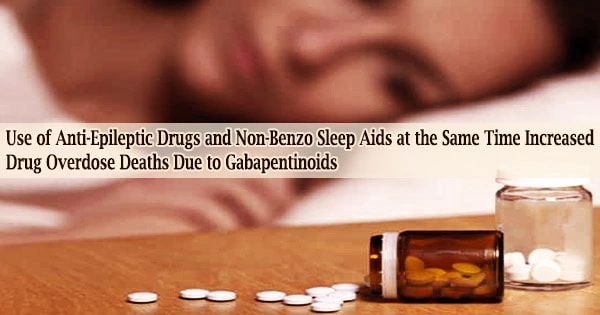Researchers at Columbia University Mailman School of Public Health sought to close the knowledge gap regarding the percentage of overdose deaths involving non-benzo sleeping/z-drugs and anti-epilepsy gabapentinoids over the last two decades and learn more about their co-usage with other substances across U.S. demographic categories.
They discovered that between 2000 and 2018, the percentage of overdose deaths involving these medications grew by more than threefold, concurrent with an exponential rise in prescriptions since their release onto the market. Data on overdose deaths with non-benzodiazepines and gabapentinoids were few until recently. The Lancet Regional Health-Americas publishes the findings.
The presence of opioids in the systems of more than 67 percent of people who died from overdoses involving these medications between 2000 and 2018 shows that combining several narcotics is the norm.
“These drug classes were introduced as less dangerous alternatives to opioids and benzodiazepines, creating perceptions among physicians and patients of their supposed increased safety, even without guidelines or data to back up such perceptions and leading to increases in prescribing,” said Silvia Martins, MD, PhD, professor of epidemiology at Columbia Mailman School, and senior author.
“Approved for short-term treatment of insomnia, they were touted as safe alternatives to the popular benzodiazepines when introduced to the market as less prone to abuse or dependence. Yet, recent evidence suggests that this alternative may also be as harmful as the product it intended to replace partially. We felt it was critical to further explore and especially determine the dangers of their co-usage.”
For each year between 2000 and 2018, the researchers computed the number of overdose deaths per 100,000 people using information from the National Center for Health Statistics.
788,135 people passed away between 2000 and 2018 with an overdose code listed as the primary cause of death. Of those, 587,884 people died from various causes, with any T or particular code for the drug involved. In addition to other causes of mortality, 21,167 of those had a T42.6/T42.7 ICD classification, which includes gabapentinoids and z-drugs.
Rates of concurrent overdose deaths with opioids and benzodiazepines are startling and the involvement of gabapentinoids and z-drugs suggests they could add risk to non-medical users of benzodiazepines and opioids rather than minimize it. As such, gabapentinoids and z-drugs should always be prescribed with caution and patients should be monitored closely.
Vitor Tardelli
In comparison to the population of all overdose fatalities between 2000 and 2018, there were more purposeful overdoses, a higher percentage of women, white people, and those with higher educational backgrounds who died from an overdose.
Gabapentinoids are frequently administered off-label for problems like anxiety and sleeplessness in addition to being used in substitution of benzodiazepines and opioids.
“The rise in gabapentin prescriptions roughly accompanies the involvement of z-drugs and gabapentinoids in overdose deaths, which suggests they can be playing a role in those deaths. The literature also has shown increasing deaths with gabapentin co-using with other substances including alcohol,” noted Martins.
The two drug classes most frequently associated with drug-related emergency room visits and drug overdose deaths in the United States are prescription opioids and benzodiazepines. Both benzodiazepines and prescription opioids induce respiratory decline when used in excess.
According to the researchers, there is enough evidence that users of one frequently take the intended replacement as well, a risky and frequently fatal practice, despite the introduction of z-drugs and gabapentinoids intended to replace benzodiazepines and opioids as safer alternatives to treat insomnia and pain.
“The positive news is that clinicians garnered some awareness about the risks of opioids after the catastrophic consequences of their widespread use, and prescriptions have decreased notably over the past 10 years,” said Vitor Tardelli, of the Universidade Federal de São Paulo, and the Centre for Addiction and Mental Health, Toronto, as well as a former Columbia Mailman school student. “Drug monitoring initiatives have already been implemented successfully to reduce prescribing of benzodiazepines as well.”
However, he also makes note of the regrettable fact that underground markets are now a significant supply of benzodiazepines, frequently with unknown potency.
“Rates of concurrent overdose deaths with opioids and benzodiazepines are startling and the involvement of gabapentinoids and z-drugs suggests they could add risk to non-medical users of benzodiazepines and opioids rather than minimize it. As such, gabapentinoids and z-drugs should always be prescribed with caution and patients should be monitored closely,” observed Tardelli.
“Clinicians and primary care doctors should take a thorough history of potential risky behaviors prior to prescribing these drugs and educate their patients about potential interactions between gabapentinoids and z-drugs with opioids, alcohol, and other sedative drugs,” said Martins.
Co-authors are Marina C. M. Bianco and Thiago M. Fidalgo, Universidade Federal de São Paulo; Rashmika Prakash, Luis E. Segura, and João M. Castaldelli-Maia, Columbia Mailman School. Dr. Martins was funded by a grant from the Columbia University President’s Global Innovation Fund.
















